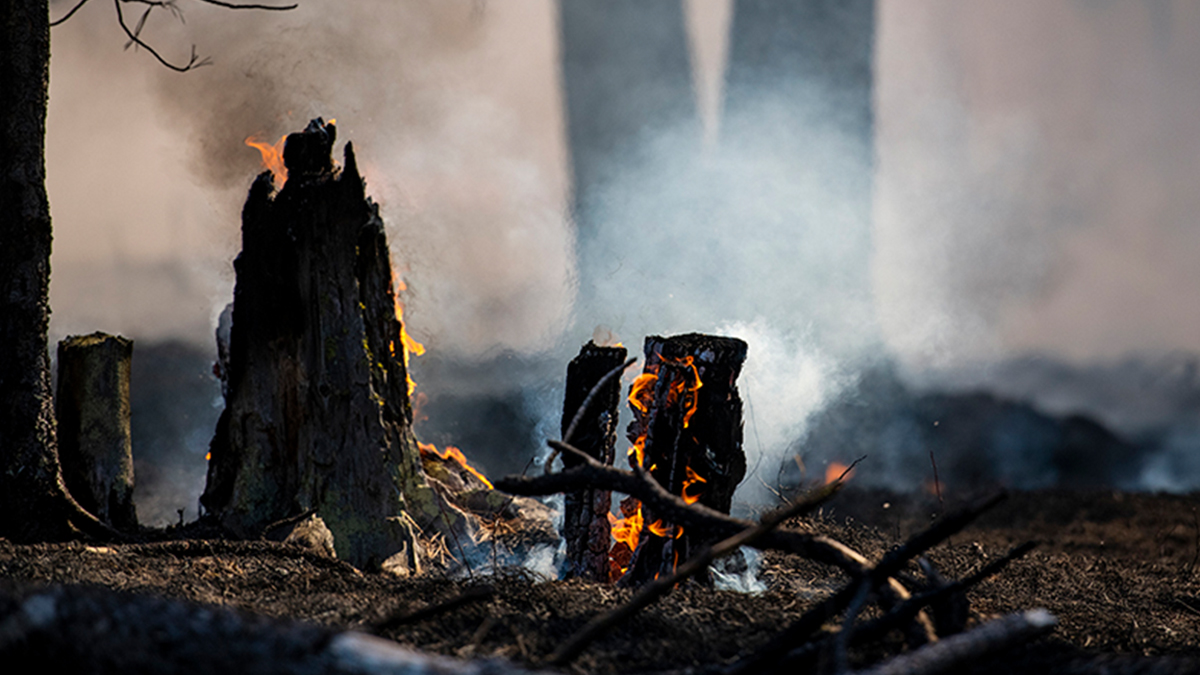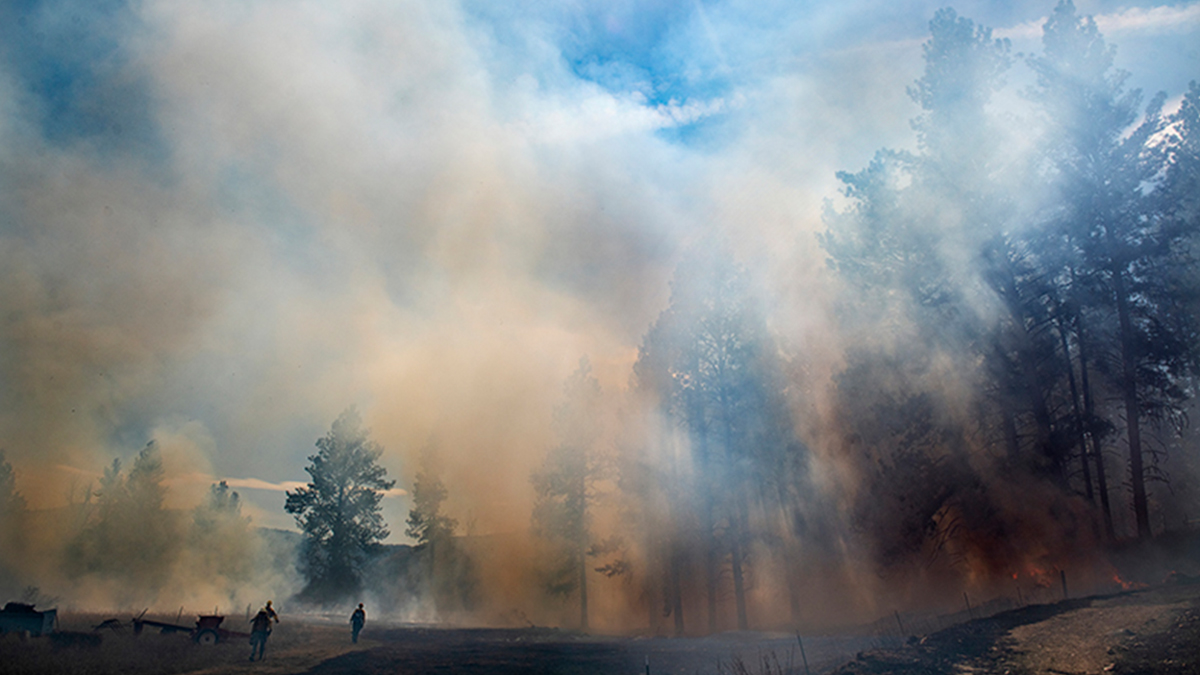Below is a news release from the University of Montana. In 2018, the Rocky Mountain Elk Foundation helped fund conifer thinning across 526 acres in advance of this prescribed burn.
In mid-April on the University of Montana-owned Bandy Ranch in neighboring Powell County, the snow was still visible on the surrounding Garnet Mountains, geese were honking overhead and Cottonwood Creek was beginning to ripple.
But there would be a greater sound of the season that day.
Tree sap, water pockets and air popping, crackling and combusting from heat, and the swinging of Pulaskis into hard ground as bright orange flames raced up conifers against a backdrop of radio static and beeps.
“The first rule of fire is that it depends on batteries,” said LLoyd Queen, UM professor and director of UM’s FireCenter. “Everything runs on batteries – headlamps, radios, weather stations.”
Prescribed fires consist of purposely burning land to reduce the risk of wildfire and jumpstart rejuvenation of plant life. It was the University’s first-time hosting a cross-boundary prescribed fire, burning both UM property and adjacent land managed by other agencies.
As the world faces bigger and scarier wildfires, researchers and fire managers working together to prevent and manage them represents a new trend in fire science, Queen said.
The day also doubled as a hot and heavy training experience for UM students, who were front and center on the burn.
“The burn has two objectives ꟷ one is ecological, one is educational,” Queen said. “The first is restoring the landscape, getting rid of debris and the second is providing an educational experience for students and partners on the burn.”
Queen was one of several FireCenter staff and UM professors in the W.A. Franke College of Forestry and Conservation who joined forces with fire scientists from the Missoula Fire Sciences Laboratory, a research institute with the U.S. Forest Service, and personnel from Montana Fish, Wildlife and Parks to manage the burn, which took about two years to plan. At about 3,500 acres, UM’s Bandy Ranch is a working cattle ranch that also serves as an exploratory extension of a classroom.
“This is a complicated prescribed burn, given the involvement of our students and combination of jurisdictions and research activities,” said Carl Seielstad, UM Fire and Fuels Program manager and associate professor. “We’ve got students, University property that’s part of the Montana Forest and Conservation Experiment Station, the Forest Service and Montana FWP, all of whom are heavily and intimately involved.”
Seielstad, who authored the burn plan and secured the required permissions for the fire, served as the day’s incident commander or burn boss – or the main guy in charge if anything went wrong.
“From a fire management perspective, we are successful when executed safely, the burn doesn’t get out of control and the treatment meets the objectives of the burn plan,” Seielstad said.
The day’s charge included the lighting by drip torch of about 108 acres of native grassland and beetle-killed pine trees that included equal parts of Bandy Ranch, research plots from the Forest Service and the Montana FWP game range adjacent to the ranch.
Management of the fire also included a mix of 12 UM undergraduate and graduate students who either are members of the UM Fire Club, majoring in forestry or completing a minor in Fire Sciences and Management. One of the squad bosses included a graduate student in UM’s Computer Science Department who studies fire behavior models when not fighting fire.
The majority of students have summer jobs as wildland firefighters, and many were on hand that day to receive certification for experience on a prescribed burn for their Red Cards, agency-issued documents that certify that an individual has the training, experience and fitness to perform duties as a wildland firefighter.
“It’s a super fun and a really great opportunity to be out here, to be able to have this experience, particularly before many of us fight fire this summer,” said Mason Banks, president of UM’s Fire Club and driver of the “gator,” an all-purpose all-terrain vehicle, that day.
As Missoula and UM both serve as a national nexus of wildland fire expertise, the burn also served as an opportunity for a host of research for interagency and University research objectives with important implications for national wildfire prediction, response and management.
Some of those projects included examining modifications of fuel structure with fire behavior, capturing 3D images for fire prediction models, better understanding how fire kills trees immediately and in the long-term documenting how energy and fuels interact for computer science models.
Russell Parsons, research ecologist with the Forest Service, was on the burn to capture footage via ground-based remote cameras to document the fire’s behavior, complementing aerial imagery captured by drone-based sensors flown by UM scientists.
“The drone allows us to see exactly what the fire is doing, down to the second,” Parsons said. “The footage will allow us to track thermal heat and watch that progression over space and time, which we plan to recreate in a computer model.”
As the country continues to see super wildfires, computational models of fire behavior can help predict fire dynamics and inform on-the-ground management and response. Parsons said the models have a particularly important role in helping managers consider different options and evaluate how prescribed fires or fuel treatments can help control fire. Parsons said he ultimately hopes to use the data to create simulation training for wildland firefighters.
“As we continue to see extreme droughts and high temperatures, we know wildfire is not going to get better, it’s going to get worse,” he said. “So, what we can do in the meantime is to model the fire so we can try to predict fuel and fire interactions in varying environments.”
Maggie Epstein, UM forestry graduate student and squad boss that day, was responsible for the safety of the firefighters and reporting directly to the fire boss. Epstein had to manage the day’s variables, including wind, fuels and moisture and delivered orders to the fire crew.
“I’m mostly in a lab between four and five days a week, so it’s nice to get out and be on the line today,” she said. “It’s exciting to be part of a burn that includes so many moving parts, objectives and agencies.”
As some parts of the fire petered out throughout the day, other areas jumped irrigation ditches and spot fires ignited outside of the containment line, adding for a bit of drama that the crew was fully prepared and trained to expect.
“Keeping fire within control lines is paramount, but threats like this are expected, planned for and they provide a learning opportunity to assess what we could change in the future to avoid these spot fires,” said Queen.
Queen said what sets UM’s expertise in fire sciences apart is that most, if not all FireCenter faculty and staff, serve as wildland firefighters when they’re not teaching or researching.
“It’s immensely important for us to not only serve as experts in the discipline, but to never lose that practice and connection with the field,” he said.
Ryan Kirk, a UM freshman from Eugene, Oregon, who is majoring in business, was also working the fire that day in preparation for spending the summer as a wildland firefighter in Wyoming.
“I’m glad to have this experience on my card, and I love being out here with other Fire Club volunteers,” he said. “A big reason why I chose UM is for these kinds of experiences. I can’t say working fire is easy or the hours aren’t long, but it’s always fun. Addicting, actually.”

(Photo source: University of Montana)
